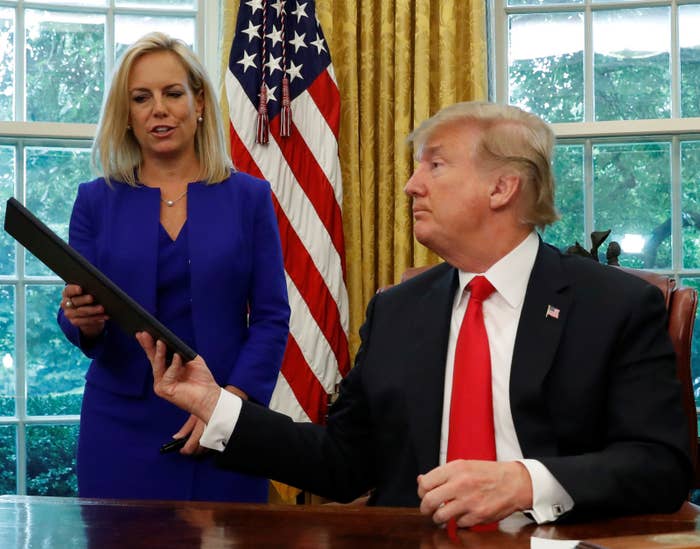
Less than an hour after President Donald Trump signed an executive order that he said would stop child separations at the border, Homeland Security Secretary Kirstjen Nielsen told Republicans that the order would not work permanently and it is still up to Congress to fix the issue.
The executive order hinges on asking a judge to change a 1997 settlement agreement that restricts how long children can be detained. Republicans do not expect this to actually succeed said Idaho Rep. Raúl Labrador, but it allows them to detain children and parents together — assuming there are available facilities — for a limited time while Congress tries to find a solution.
“[The executive order] gives us at least some time to deal with it legislatively,” said Labrador. “It’s basically buying a few weeks.”
But there’s one big problem — while Republicans and Democrats agree that children should not be separated from their parents at the border, they wildly disagree on how to fix the problem.
“This is one of the bigger divides I’ve ever seen here,” said Democratic Sen. Chris Coons of Delaware.
Even ahead of Trump’s decision to sign the order, the debate on Capitol Hill had already fallen to partisan gridlock, leaving Congress heading toward a dead end where none of the half dozen proposals members have put together this week become law.
The question dividing politicians is how to keep families together. It’s complicated by past court decisions that prevent the government from keeping children detained in immigrant detention facilities indefinitely (the same legal problem at issue with Trump’s order).
That leaves two options for keeping families together — changing the laws so that children can be kept in custody with their parents for long periods of time, or releasing the entire family from custody.
Both sides are becoming increasingly embittered. Just as Trump was signing the order Wednesday, Senate Majority Whip John Cornyn took to the Senate floor to excoriate the Democratic proposal, calling it a “get-out-of-jail-free card” for adults who cross the border illegally and dubbing it a “zero enforcement program.” Meanwhile, House Minority Whip Steny Hoyer accused House Republicans of “lying” about their proposals in a statement calling legislation in the House an “anti-immigrant bill” that “does not solve the family separation crisis.”
House Republicans are moving forward with an immigration bill that would adopt the first approach, and Trump says he’s on board with it. The so-called “compromise bill” negotiated between Republicans, but with no Democratic input, would effectively attempt to rewrite a legal settlement reached by the Clinton administration in 1997 involving how to humanely detain minors.
If passed both chambers and was signed into law, the bill would allow the US government to hold minors with their parents indefinitely — removing the 20-day time limit on keeping children detained — while also mandating that they must be kept with their parents.
But when a parent claims asylum, it can take months or even as long as two years to have their case resolved. Democrats argue keeping children — and even adults — detained during a wait that long is inhumane. Democratic Senate Whip Dick Durbin said his party would push back hard against removing the legal protections.
“After a decade of bargaining back and forth we came down with some basic standards, humane standards, on the treatment of children. Nielsen and the Trump administration have made it clear they want to get rid of that,” Durbin said. “They’re in for a fight, because that is at the heart of this controversy.”
But Democratic proposals have also failed to gain any traction across the aisle. Notably, a bill from California Sen. Dianne Feinstein is supported by every Democratic senator but not one Republican.
Feinstein’s bill would ban the practice of separating children from their families. But keeping families together isn’t possible in detention facilities. Under the 1997 settlement and a 2016 circuit court of appeals ruling, the government is legally required to move children to the “least restrictive setting” after 20 days of detention. That effectively means the only way to keep the whole family together is to release the parents with them.
That was the approach taken by the Obama administration. Republicans attacked this policy as “catch and release” because once released many families never showed up for their asylum hearings.
“We’ve got to find a way to keep families together and make sure they show up for the hearings,” said Republican Sen. Lindsey Graham. “I don’t know if you put ankle bracelets on people, I don’t know what you do. But the point is a system where people get detained and never show up doesn’t work.”
The Obama administration tried to address the no-show issue with a counseling program that provided legal representation to asylum-seekers. That program improved the turnout rates, but it was shut down by the Trump administration.
It’s not clear what will happen now. Trump’s executive order relies on a court agreeing to make changes to the 1997 settlement in order to keep families together in detention.
Without a fix, members of Congress will have to explain to voters in this fall’s midterm election why children are still being taken away from their parents.
“How can you? How can anyone defend this practice on any grounds?” said Republican Sen. Jeff Flake, who is not running for re-election.

